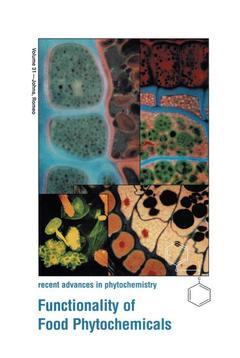Functionality of Food Phytochemicals, Softcover reprint of the original 1st ed. 1997 Recent Advances in Phytochemistry Series, Vol. 31
Langue : Anglais
Coordonnateurs : Johns Timothy, Romeo John T.

Phytochemists are aware that their focus of interest is receiving attention from a wider segment of society and from a greater diversity of disciplines within the scientific community than ever before. Nonetheless, they were bemused to learn three years ago that "until recently scientists didn't even know phytochemi cals existed" (Newsweek, April 24, 1994). Changing public perception of the positive contributions of phytochemicals to human well-being has foundations in scientific advances. With popular reports emphasizing the important implica tions of phytochemicals in the daily lives of people, there is a pressing need for those working in this area to explain their diverse scientific activities to the public. Chemicals from plant foods are linked through epidemiological and ex perimental studies with reduced incidence of chronic degenerative diseases. Phytomedicines, standardized according to particular constituents, are making increasing contributions to health care. Naturally occurring constituents of plants are recognized as fundamental to the appeal, quality, and marketability of food products. In light of such developments, perceptions by phytochemists of their own discipline and its applications are expanding. Until recently, food phyto chemistry largely implied food toxicants. Food plants were familiar, but seldom the source of novel economically important compounds. Increasingly sophisti cated methods of analysis, however, have opened new opportunities for under standing the nature and functions offood constituents, and for manipulating them to improve the quality, acceptability, and value of food products.
Peeling the Onion; E. Block, et al. Health Promoting Phytochemicals in Citrus Fruit and Juice Products; A. Montanari, et al. Chemopreventive Agents in Foods; B. Stavric. Constituents of Wild Food Plants; A. Sotelo. Biology and Biochemistry of Underground Plant Storage Organs; H.E. Flores, T. Flores. Behavioral Determinants for the Ingestion of Food Phytochemicals; T. Johns. Phytochemicals and Wine Flavor; S.E. Ebeler. Food Colorants from Plant Cell Cultures; F. Cormier. Transgenic Manipulation of Edible Oilseeds; T. Voelker. Quantitative Microscopic Approaches to Carbohydrate Characterization and Distribution in Cereal Grains; R.G. Fulcher, et al. Index.
Date de parution : 10-2012
Ouvrage de 273 p.
Disponible chez l'éditeur (délai d'approvisionnement : 15 jours).
Prix indicatif 52,74 €
Ajouter au panierThèmes de Functionality of Food Phytochemicals :
Mots-clés :
biochemistry; biology; cell culture; chemistry; development; plant; plants
© 2024 LAVOISIER S.A.S.



